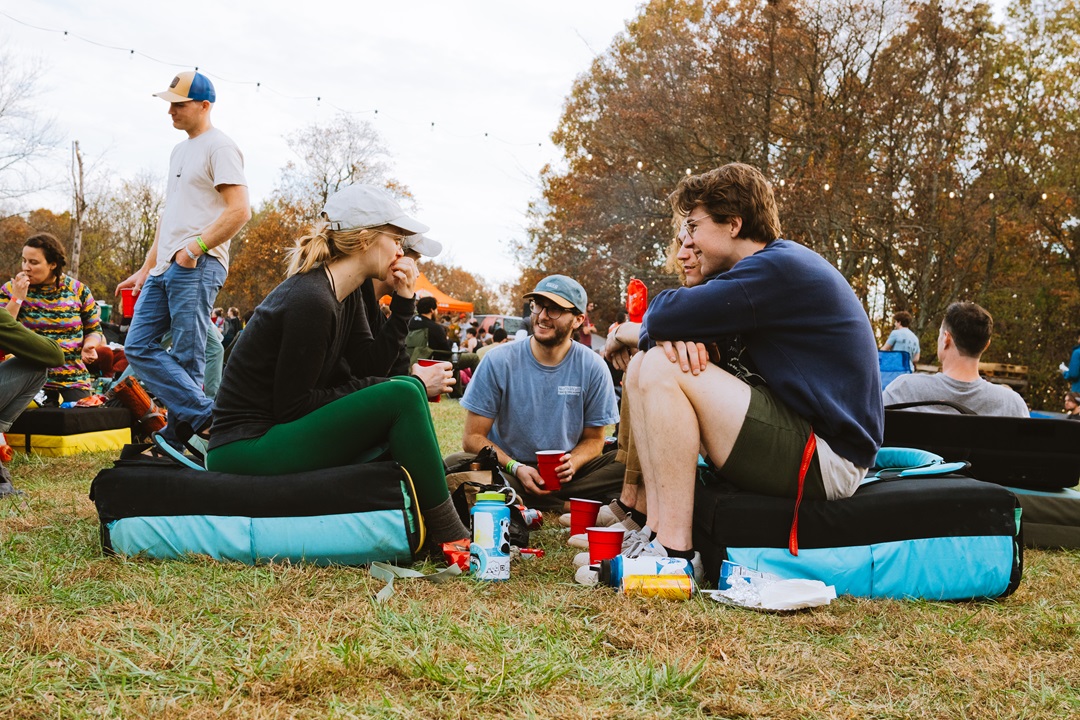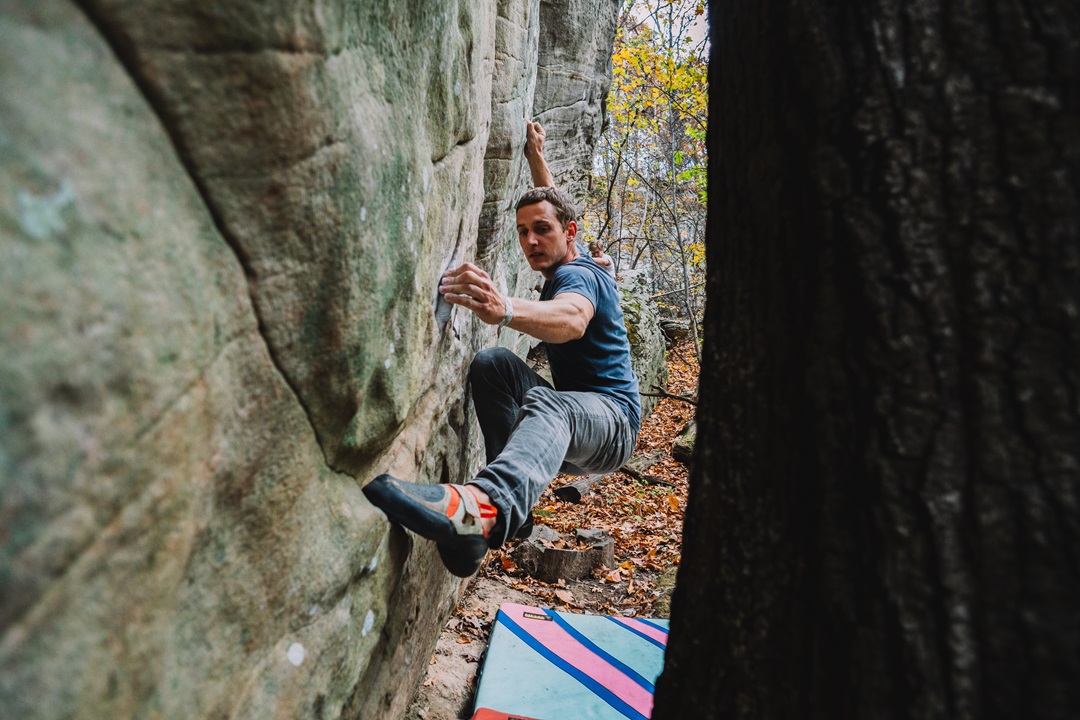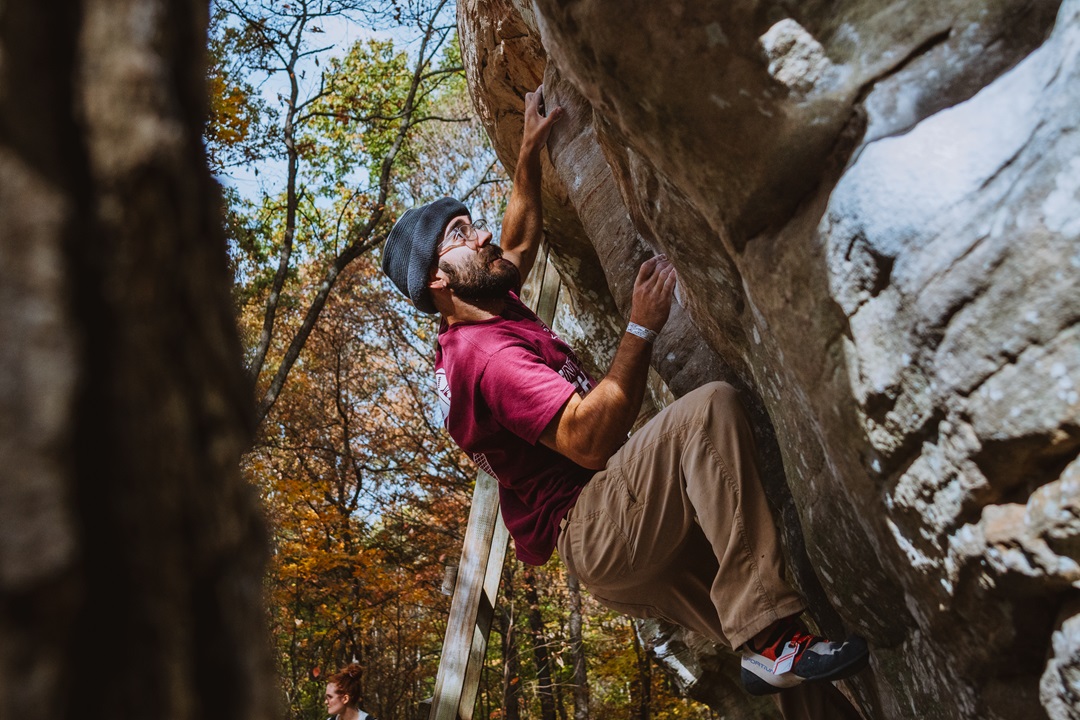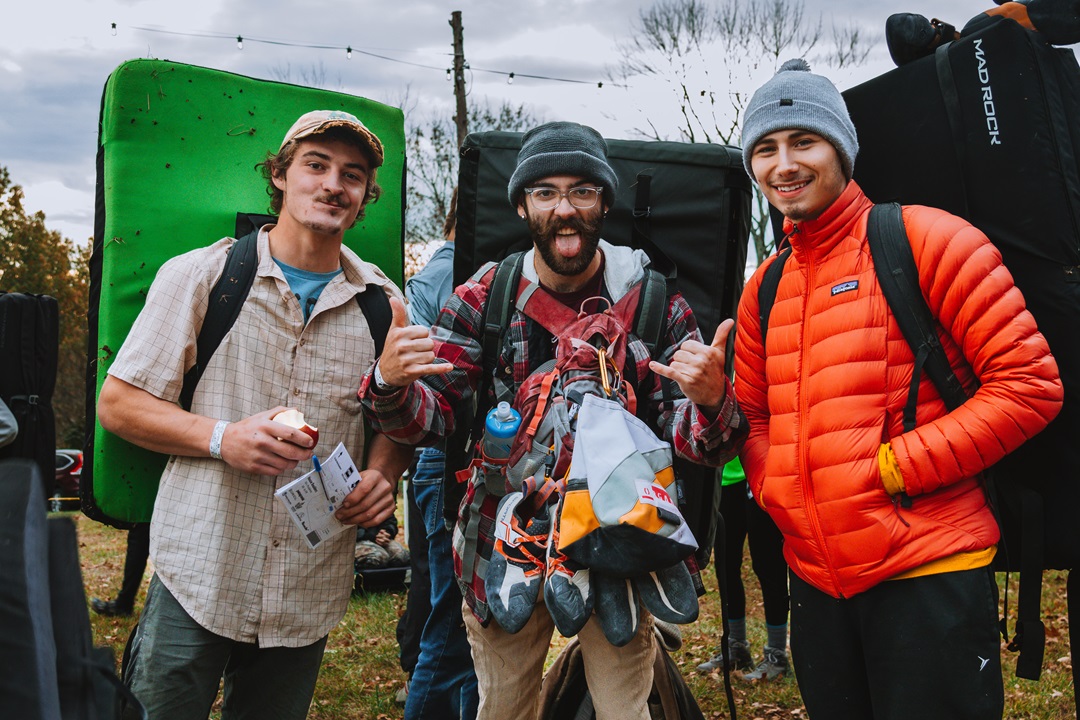Each year, on the first weekend in November, hundreds of climbers from all over the country gather on a remote plateau near Alto Pass, Illinois, drawn by the impressive, massive rock formations that make up the Holy Boulders. The event, known as the Pilgrimage, is part climbing competition, part fundraiser, and all community. Now in its 11th year, the Pilgrimage has become a marquee climbing event in the Midwest.
In 2004, climber Aaron Brouwer stumbled upon the massive sandstone boulders. At the time, the land was owned by the Tripp family, and Brouwer began to build a relationship with them. The Holy Boulders, also known as the Holies, were a closely guarded secret, with climbers limiting visits to ensure continued access. In 2012, the Tripp family decided to sell the land, and local climbers, as part of the Illinois Climbers Association (ICA), sprang into action. The organization collaborated with the Access Fund, which secured a $185,000 loan from the Climbing Conservation Loan Program to purchase the Holy Boulders. In 2016, the Access Fund transferred ownership and stewardship of the land to the ICA. Then, in 2021, the organizations joined forces again to acquire the House Boulders, an extension of the Holies.
After the purchases, the ICA faced a grand dilemma: How would they raise money to repay this significant sum while still guaranteeing free access to the Holies? In 2012, ICA members organized the first Pilgrimage; for a fee, climbers could camp on the plateau above the Holies, which is prohibited at any other time of year. The ICA organized a point-based competition for the boulders, hosted an after-party with dinner, and used the profits to repay the loan. The Pilgrimage, from its humble beginnings with 50 competitors, has grown to nearly 500 in 2023, a testament to the excitement and anticipation for this unique offering. Last year’s event alone raised $29,000, according to Mimi Harzan, ICA’s secretary and head of the Pilgrimage Committee.
Climbers can visit Holy Boulders year-round to climb, but the Pilgrimage delivers a bit of magic to an already beautiful place. While nominally a competition (with the prize being a plaque), climbers don’t come to win cash or bragging rights. “It’s really about meeting people and climbing with all of these people around,” Harzan says. Get on any boulder, and you’ll be met with encouragement and cheers from complete strangers. “No one will be like, ‘Don’t look at my beta, I’m trying to get a better scorecard,’” she adds.
People freely share techniques and advice about certain moves or their favorite boulders. “I loved it because it was a diverse group of climbers from all over who wanted to climb hard but have fun in the process,” says Josh Farmer, an Illinois native and 2023 competitor.
The event is ideal for new climbers or those new to climbing outside. Before the competition, ICA members painstakingly tape small cards with the name, difficulty, and point value to each boulder problem, helping first-time visitors understand and navigate the area. Each major boulder has an ICA member standing by, ready to offer help, give directions, or assist in spotting. Climbing during the Pilgrimage is probably the safest time to boulder outside. A sea of crash pads covers the ground, and an army of other competitors acts as spotters. With boulders in every style, from slab to overhung to vertical, climbers can hold themselves on minuscule crimps or pull big, dynamic moves. Whether you climb V0 or V12, you’ll be able to find a boulder problem that speaks to you and provides a challenge.

There’s plenty of time for fellowship at the Pilgrimage. (Cody Nieset)
For boulderers, the Midwest can feel like a desert, devoid of quality options and intriguing problems. Jackson Falls, the area with the most climbing routes in Illinois, has over 500 rope routes but only seven boulders. Climbers in Iowa and Nebraska have such a shortage of boulders that their nearest destinations are four hours or more away. Missouri has emerging areas such as Robinson Bluff and Sage Mountain, as well as Elephant Rocks, but still, it’s hard to overstate the bouldering mecca that the Holy Boulders represent for regional climbers. Nowhere else can they find such a high concentration of well-developed, safe routes on quality rock.
“The ICA’s work securing and developing the Holy Boulders as a public area has been a massive benefit to Midwestern climbers,” says Morgan Miller, a St. Louis-based climber and 2023 participant. “The Pilgrimage is all the best parts of climbing: cheering each other on, trying hard, and building community.”
While technically only a single-day event, the ICA is developing plans to grow the Pilgrimage into a weekend-long festival. Climbers typically arrive on Friday night and climb and compete on Saturday. The day ends with a cookout and dinner provided by the ICA, a raffle and awards ceremony, and music and fellowship late into the night. On Sunday, some climbers stick around to get more routes in or to return to a boulder they didn’t complete on Saturday.
“We’d like to spread out activities and make more available on Friday night or Sunday morning,” says Harzan. “We’ll try to have more vendors and things for people to do the entire weekend.”

A competitor climbs “Undercling King.” (Cody Nieset)
This year’s Pilgrimage will mark the first year the ICA no longer has a loan to repay. The 2023 event provided enough money for the organization to fully repay the original Holies loan and the additional $90,000 loan for the House Boulders extension. Moving forward, the ICA will use the funds from the Pilgrimage for continued land stewardship and development of other climbing areas. “We’ll be doing controlled burns,” says Harzan. “That’s generally good practice and property management. We have plans for trail improvement.”
The ICA will also use the funds to purchase hardware to develop sport climbing routes at nearby Ferne Clyffe State Park. “The Pilgrimage funds the ICA as a whole,” Harzan explains. “It’s a large part of our overall fundraising strategy. The majority of our funds come from that single fundraiser.”
In addition to the Holies and Ferne Clyffe, the ICA also manages climbing routes at Jackson Falls, Giant City State Park, Pere Marquette State Park, Cedar Bluff, and Alto Pass. The average sport climbing route can cost $100 to $300 to bolt and equip safely. Every competitor at the Pilgrimage means more funds for the ICA to continue this extensive management project.
The Pilgrimage is a grand testament to the power of the climbing community and its collective impact. The ICA, run entirely by volunteers, works tirelessly for months to execute a safe, welcoming event that is essential to preserving climbing access and natural conservation in the Midwest. Organizing and running such a massive event is no small feat, but the ICA members find fulfillment in its larger purpose. For her part, Harzan says that amidst the chaos of the world, the Pilgrimage is a source of joy, fun, and camaraderie that she can actively engage in.
“This is something we can all do and see an immediate impact in our community,” she says. “Climbing is something we’re passionate about, and this is a way we can make change.”

There’s something for most climbers at the Pilgrimage. (Cody Nieset)
2024 Pilgrimage
This year’s Pilgrimage will take place November 1-3. The registration fee includes camping on Friday and Saturday, dinner and beer on Saturday, and a T-shirt. The number of competitors is capped at 400. Spectator tickets are available until October 18 for those wishing to attend but not compete. Register at ilclimbers.org/competition.
Author: Mary Andino is a contributor to Terrain.
Top photo: Climbers unwind at the Pilgrimage. (Cody Nieset)


Leave A Comment